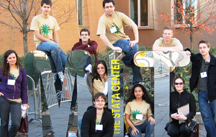Sean Rushton

Returning to normalcy after winning silver at one of the most prestigious student research contests in the world is no easy feat, especially if it is your first time competing. Yet, such was the recent experience of a uOttawa interdisciplinary team after turning heads at the fifth annual International Genetically Engineered Machine (iGEM) competition, at MIT in Boston.
“What the team has achieved goes way beyond my initial hopes and expectations,” says the Faculty of Medicine’s Dr. Mads Kaern, who organized uOttawa’s participation in the event. “I am quite honestly in total awe of their accomplishments.”
Established in 2003 as a biotechnology incubator that aims not only to develop novel biotechnologies, but also to foster creativity and entrepreneurship, iGEM provides students with experience and expertise beyond what is taught in the classroom. This year, 84 teams with more than 1,000 participants from 21 countries from Asia, Europe, Latin America and North America participated in the competition by designing, building, and testing simple biological systems made from standard, interchangeable biological parts.
The 2008 uOttawa iGEM team was composed of 10 undergraduate students from various programs ranging from neuroscience, biomedicine, biopharmaceuticals, physics, math, biotechnology, chemical engineering and business administration, as well as Drs. Kaern (Systems Biology), Illimar Altosaar (Biochemistry, Microbiology and Immunology) and Doug Johnson (Plant Molecular Biology).
The team captured the silver medal by developing the Pulsilator, a yeast capable of signaling protein production in pulses rather than continuously. Multi-billion dollar industries depend on the production of artificially assembled proteins, but are hampered by the relatively short lifespan of proteins under continual high-rate synthesis. By regulating synthesis in short bursts, the Pulsilator would allow proteins to remain competent for much longer periods of time—a windfall for numerous applications including anti-cancer therapeutics and antiseptics.
“It helps to think of our innovation like a marathon strategy,” says Tammy Tye, a member of the uOttawa iGEM team and an undergraduate in Biopharmaceutical Science. “It is easier to run a long distance — using a series of sprints with time to rest in between — than it is to sprint the entire thing.”
The students not only designed and managed the science project, they raised the funds to support their work and were involved with the Ottawa community by participating in science awareness programs and meetings with influential representatives, including the Government of Ontario and BIOTECanada, a national organization representing other health care, agricultural, food, and research groups involved in biotechnology.
While the launch of the iGEM program was facilitated by Drs. Kaern, Altosaar and Douglas, it received broad support from across the University and from a number of faculties. For the University, the program hit the bull’s eye in terms of Vision 2010, the academic strategic plan,
“My goal,” says Dr. Kaern, “was simply to get the students excited about science and technology, including business and ethical aspects, by giving them the room to explore and interact with one another in a high intensity, small-team setting that bridges programs in science, engineering, medicine and business.”
“The students have done the University proud by proving that it can compete with the best both nationally and internationally. I’m looking forward to help further improve and expand the program for next year."